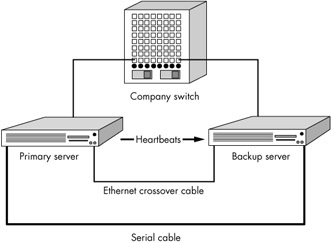The Physical Paths of the Heartbeats
The Heartbeat program running on the backup server can check for heartbeats coming from the primary server over the normal Ethernet network connection, but normally Heartbeat is configured to work over a separate physical connection between the two servers. This separate physical connection can be either a serial cable or another Ethernet network connection (via a crossover cable[1] or mini hub, for example).
Heartbeat will work over one or more of these physical connections at the same time and will consider the primary node active as long as heartbeats are received on at least one of the physical connections. Figure 6-1 shows three physical connections, or paths, between the servers. The first path, the normal Ethernet network used to connect systems to each other on the network, is the least preferred for sending the heartbeats, because it will add extra traffic to your network (though this is a trivial load under normal circumstances). Your choice of whether to use one or more new serial or Ethernet connections will depend on your situation.

Figure 6-1: Physical paths for heartbeats
| Note | High-availability best practices dictate that heartbeats should travel over multiple independent communication paths.[2] This helps eliminate the communications path from being a single point of failure. |
Serial Cable Connection
A serial connection is slightly more secure than an Ethernet connection, because a hacker will not be able to run telnet, ssh, or rlogin over the serial cable if they break into one of the systems. (The serial cable is a simple crossover cable connected to the COM port on each system.) However, because serial cables are short,[3] the servers must be located near each other, usually in the same computer room.
Ethernet Cable Connection
Using a new Ethernet network (or Ethernet crossover cable) eliminates any distance limitation between the servers. It also allows you to synchronize the filesystems on the two servers (as described in Chapter 4) without placing any extra network traffic on your normal Ethernet network.
Using two physical paths to connect the primary and backup servers provides redundancy for heartbeat control messages and is therefore a requirement of a no-single-point-of-failure configuration. The two physical paths between the servers need not be of the same type; an Ethernet and a serial connection can be used together in the same configuration.
Partitioned Clusters and STONITH
For true redundancy, two physical connections should carry heartbeat control messages between the primary and backup server. These two physical connections will help prevent a situation where a network or cable failure causes both nodes to try and assume ownership of the same resources. This condition is known as a split-brain or partitioned cluster,[4] and it can have dire consequences if you are using two heartbeat nodes to control one physical device (such as a shared SCSI or Fibre Channel disk drive). To avoid this situation, take the following precautions:
-
Create a redundant, reliable physical connection between heartbeat nodes (preferably using both a serial connection and an Ethernet connection) to carry heartbeat control messages.
-
Allow for the ability to forcibly shut down one of the heartbeat nodes when a partitioned cluster is detected.
This second precaution has been dubbed "shoot the other node in the head," or STONITH. Using a special hardware device that can power off a node through software commands (sent over a serial or network cable), Heartbeat can implement a Stonith[5] configuration designed to avoid cluster partitioning. (See Chapter 9 for more information.)
| Note | It is difficult to guarantee exclusive access to resources and avoid split-brain conditions when the primary and backup heartbeat servers are not in close proximity. You will very likely reduce resource reliability and increase system administration headaches if you try to use Heartbeat as part of your disaster recovery or business resumption plan over a wide area network (WAN). In the cluster solution described in this book, no Heartbeat pairs of servers need communicate over a WAN. |
[1]A crossover cable is simpler and more reliable than a mini hub because it does not require external power.
[2]In Blueprints for High Availability, Evan Marcus and Hal Stern define three different types of networks used in failover configurations: the Heartbeat network, the production network (for client access to cluster resources), and an administrative network (for system administrators to access the servers and do maintenance tasks).
[3]The original EIA-232 specification did not specify a distance limitation, but 50 feet has become the industry's de facto distance limit for normal serial communication. See the Serial HOWTO for more information.
[4]Sometimes the term cluster fencing or i/o fencing is used to describe what should happen when a cluster is partitioned. It means that the cluster must be able to build a fence between partitions and decide on which side of the fence the cluster resources should reside.
[5]Although an acronym at birth, this term has moved up in stature to become, by all rights, a word—it will be used as such throughout the remainder of this book.
EAN: 2147483647
Pages: 219